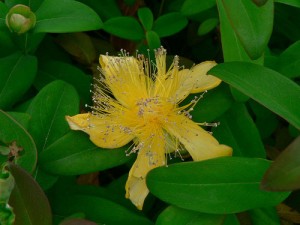St. John’s Wort
Botanical Name: Hypericum perforatum
St. John’s Wort is native to the United States and Europe, and is a perennial plant that grows beside country paths and on sunny edges of woodlands. The use dates back to the ancient Greeks, Hippocrates recorded the medical use of St. John’s wort flowers. It was given its name because it blooms around June 24th, the birthday of John the Baptist. The medicinal benefits of the plant stem from a high concentration of hypericin, a red pigment that exudes from the flowers, and from pseudohypercin. Hypercin is thought to be responsible for the known antidepressant effect of St. John’s Wort. In addition, the plant has antibiotic and antiviral capabilities and has long been used to help heal wounds.
Characteristics:
- Its small, bright yellow flowers consist of five petals with long, feathery stamens at the center. The slender, oval leaves grow in opposite pairs. If held up to the light, the leaves often appear to be perforated
Uses:
- The fresh flowers can be used to make an oil that has proved particularly curative for skin problems, bruises and rheumatic ailments.
- St. John’s wort extracts improves mood, and decreases anxiety and insomnia related to depression.
- Some research shows that a combination of St. John’s wort, plus black cohosh can help improve menopausal symptoms.
- It may also decrease alcohol intake. The constituent hyperforin, has been said to decrease alcohol consumption.
- When the oil is rubbed onto the belly and breasts during pregnancy it can help prevent stretch marks, and is useful to treat hemorrhoids and aching, swollen veins that can occur during pregnancy.
- The aerial parts of the plant can be cut and dried for use in herbal tea.
Gardening tips:
- Plant in a sunny, warm location, but will grow in partial shade.
- Likes well drained soil, not too moist, with high humus content.
- Depending on water and nutrients it will reach a height of 2-3 ft.
- Harvest between June and august, traditionally around June 24, near the time of the summer solstice.
- The summer solstice can be a magical day. St. John’s Wort can be used to ward off fears, ghosts and nightmares; it is also known as the ”witches herb”.
Care:
- Fertilize St. John’s wort with compost in the spring and feed it with organic fertilizer as necessary.
- It does not thrive in waterlogged soil, but tolerates dryness well.
- Cut back the stems to just above ground level in the fall.
Harvesting and processing:
- You can harvest from June to August, the fresh plant contains the highest active constituent contents at the end of June.
- For tea, gather the upper non-woody parts and hang them in a dark place with the flower heads down.
- Use only the flowers to make herb oil.
Tip : St. John’s wort can be identified by pinching the leaves or flowers, which will turn red due to the release of hypericin. The red pigment was said to represent the blood of St. John the Baptist.
References:
- The Complete Guide to Natural Healing
Note: Consult with a Physician or certified herbologist if you are seeking medical remedies. The information is not intended as medical advice. PagansWorld.org is not liable for the misuse of the herb listed above.
Thanks for stopping by! Well wishes to you all, have a great day!





